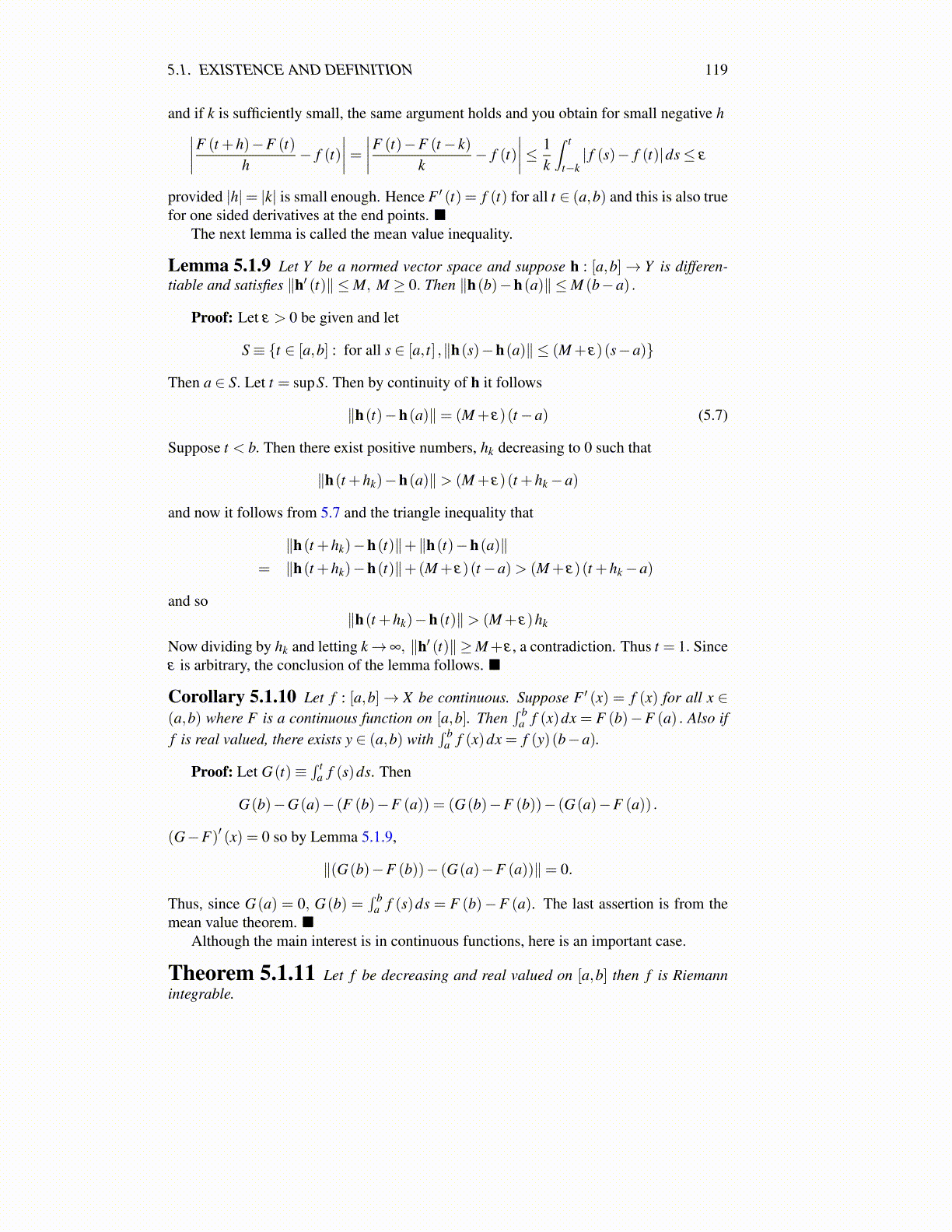
5.1. EXISTENCE AND DEFINITION 119
and if k is sufficiently small, the same argument holds and you obtain for small negative h∣∣∣∣F (t +h)−F (t)h
− f (t)∣∣∣∣= ∣∣∣∣F (t)−F (t− k)
k− f (t)
∣∣∣∣≤ 1k
∫ t
t−k| f (s)− f (t)|ds≤ ε
provided |h|= |k| is small enough. Hence F ′ (t) = f (t) for all t ∈ (a,b) and this is also truefor one sided derivatives at the end points. ■
The next lemma is called the mean value inequality.
Lemma 5.1.9 Let Y be a normed vector space and suppose h : [a,b]→ Y is differen-tiable and satisfies ∥h′ (t)∥ ≤M, M ≥ 0. Then ∥h(b)−h(a)∥ ≤M (b−a) .
Proof: Let ε > 0 be given and let
S≡ {t ∈ [a,b] : for all s ∈ [a, t] ,∥h(s)−h(a)∥ ≤ (M+ ε)(s−a)}
Then a ∈ S. Let t = supS. Then by continuity of h it follows
∥h(t)−h(a)∥= (M+ ε)(t−a) (5.7)
Suppose t < b. Then there exist positive numbers, hk decreasing to 0 such that
∥h(t +hk)−h(a)∥> (M+ ε)(t +hk−a)
and now it follows from 5.7 and the triangle inequality that
∥h(t +hk)−h(t)∥+∥h(t)−h(a)∥= ∥h(t +hk)−h(t)∥+(M+ ε)(t−a)> (M+ ε)(t +hk−a)
and so∥h(t +hk)−h(t)∥> (M+ ε)hk
Now dividing by hk and letting k→∞, ∥h′ (t)∥ ≥M+ε , a contradiction. Thus t = 1. Sinceε is arbitrary, the conclusion of the lemma follows. ■
Corollary 5.1.10 Let f : [a,b]→ X be continuous. Suppose F ′ (x) = f (x) for all x ∈(a,b) where F is a continuous function on [a,b]. Then
∫ ba f (x)dx = F (b)−F (a) . Also if
f is real valued, there exists y ∈ (a,b) with∫ b
a f (x)dx = f (y)(b−a).
Proof: Let G(t)≡∫ t
a f (s)ds. Then
G(b)−G(a)− (F (b)−F (a)) = (G(b)−F (b))− (G(a)−F (a)) .
(G−F)′ (x) = 0 so by Lemma 5.1.9,
∥(G(b)−F (b))− (G(a)−F (a))∥= 0.
Thus, since G(a) = 0, G(b) =∫ b
a f (s)ds = F (b)−F (a). The last assertion is from themean value theorem. ■
Although the main interest is in continuous functions, here is an important case.
Theorem 5.1.11 Let f be decreasing and real valued on [a,b] then f is Riemannintegrable.